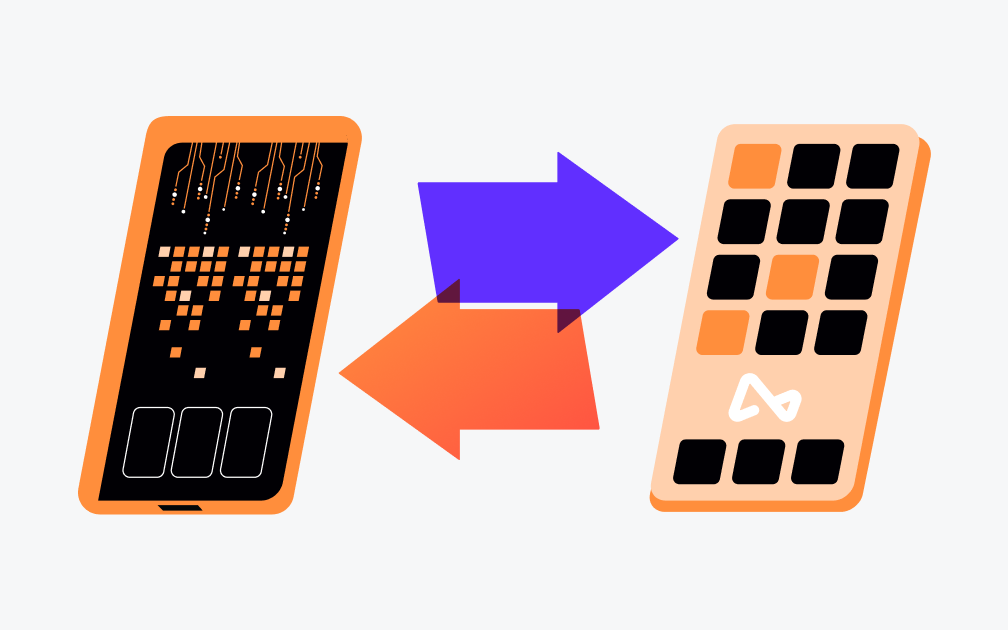International wire transfer: How to quickly send money abroad

- •What is an international wire transfer?
- •How do international wire transfers work?
- •Transfer money internationally through your bank online
- •Transfer money in person or over the phone
- •Use international transfer services to send payments
- •International wire transfers: things to know
- •International wire transfers: Frequently asked questions
- •Airwallex cuts costs without sacrificing service
Key takeaways:
International wire transfers are easily completed via your bank within 1-5 business days.
If you send wire transfers through your bank, expect to pay transaction fees and foreign exchange rates.
Alternative providers, like Airwallex, can cut costs and time for businesses with superior FX rates and multi-currency bank accounts.
Wire transfers are a common method to send money domestically and internationally, with institutions like SWIFT facilitating over 44 million transfer messages daily.1 This payment method plays a crucial role in today’s global economy.
This article explains how international wire transfers work and assesses the pros and cons of wiring money. It'll then look at some SWIFT transfer alternatives that may be more efficient and cost-effective for international businesses.
What is an international wire transfer?
An international wire transfer is a method of electronically transferring money between people or businesses. It’s also known as a telegraphic transfer or electronic transfer of funds.
When money is wired, it travels through a network of banks to reach the recipient. Because some banks don’t have a direct correspondent relationship, intermediary banks may be used to help route international wire transfers and facilitate the transfer.
How do international wire transfers work?
The process is secure but relatively expensive due to fees charged by each financial institution the money passes through. Here are the steps involved in carrying out an international wire transfer:
Sending: The sender can initiate a wire transfer either online, in person at a bank branch, or via a mobile app. They provide information about the recipient’s bank account and the transfer amount.
Verification: The sender’s bank or financial institution verifies the sender’s identity and checks they have the necessary funds.
Processing: The sending institution debits the sender's bank account for the transfer amount, along with any associated fees. The transfer request is then transmitted to the recipient's bank through a secure system.
Intermediaries: Wire transfers may pass through intermediary banks en route to the recipient's bank.
Receiving: The receiving institution receives the funds and credits the recipient's account with the transferred amount.
International wire transfers are a convenient way for anyone to transfer money across borders and seas, and there are a few ways to get it done. Typically, you work with your bank in-person, online, or over the phone. But there are also alternative international transfer services that can help you send and receive money quickly:
Transfer money internationally through your bank online
Most banking services are now available online, including domestic and international wire transfers. Search your bank’s website or online member portal to find the specific process, but here’s how it typically works:
Log in to your online banking portal and find “wire transfers.”
Submit recipient information, such as their name, bank name and address, account number, account type, and SWIFT code.
Specify the transfer amount, including the received currency for the deposit.
Pay all fees, including transfer costs (for each and every bank that handles the money) and any foreign exchange rates.
After that, the bank takes over and will contact the recipient’s bank and the necessary intermediary banks to complete the transfer. This process can take up to five days.
Transfer money in person or over the phone
If online isn’t for you, banks also initiate international wire transfers in person and over the phone. The process is pretty similar to the online banking service:
Contact your bank in person or over the phone to initiate a transfer.
Submit all relevant information, including your personal details and the recipient’s personal and banking information.
Recipient bank’s name and address
Recipient’s name and address
Recipient’s account number and account type
Recipient bank’s SWIFT code
Confirm your transfer amount and received currency.
Pay your service fees.
This process isn’t any faster or cheaper than online, but you can ask questions directly and confirm everything is ready for transfer more easily.
Use international transfer services to send payments
Finally, you can skip your regular bank altogether and complete international transfers with alternative providers.
Again, this process looks a lot like the online banking transfer option, but the specific interface and fees vary between providers. They also have more specialty features to cater to individual needs.
For example, Airwallex is an all-in-one solution for international businesses to maintain multi-currency global accounts, and for businesses to easily accept payments and make multi-currency expenses quickly, and affordably. It even has payment APIs to programmatically manage financials, including payments, payouts, and more.
Businesses that regularly transact with different currencies may benefit from a multi-currency business account that Airwallex offers since we already support the most common global currencies.
International wire transfers: things to know
International wire transfers are secure and widely used for global finances. Wire transfers are commonly accessible as both individuals and businesses have access to wire transfers via their bank. But there are important regulation details, hidden fees, and safety tips you need to know.
Pros: | Cons: |
|---|---|
Secure transfer routes through established banks | A manual process less suited for cross border payments at scale |
Accessible process for individuals and businesses | Relatively expensive with hidden fees and opaque exchange rates |
Transfers work all over the world | Inefficient and slow — takes up to five business days to transfer |
Hidden fees and FX rates
Several costs are associated with international wire transfers. Here are the key fees to know:
Transaction fees: These are charged by both the sender’s bank and the receiver’s bank, as well as any intermediary banks involved. These fees often increase when sending money across borders.
Exchange rate margins: Banks usually charge a higher foreign-exchange rate than the standard interbank rate. This hidden markup may be difficult to calculate before sending money internationally, which adds complications to financial planning.
Fees vary by service provider, so shop around to find the best rate. And you don’t have to stick with your bank.
Airwallex offers a faster and more cost-efficient alternative to traditional wire transfers, enabling businesses to send instant payments around the world via local payment routes at market-leading rates while expense management software in one place.
Limitations and regulations
International wire transfers come with its own rules and regulations set and enforced by local banking regulations and transfer service providers themselves.
There's no dollar limit to how much you can legally transfer, but your bank or transfer service might have its own rules to follow.
Regulations also vary from country to country. For example, the United States Internal Revenue Service will want to see your international wire transfers reported, and they’re particularly interested in cumulative transfers over US $10,000. Your bank will report any large transfers to cover their liability and help identify any suspicious activities.2
So, the higher the transfer’s value, the more requirements a provider or local banking regulations may enforce for the transfer. A $10,000+ transfer in the U.S. might require that you provide:
Proof of source documentation to validate where the money comes from.
Personal wealth documentation about your typical income streams.
Proof of ID and further information about the recipient.
Purpose of the transfer.
Depending on the transfer, you’ll also have to pay taxes on the amount. This is particularly true if you exceed a certain dollar amount transferred into a foreign bank account or send transfers for business purposes.
Risks and safety measures
Wire transfers are generally considered to be a secure method of transferring funds. However, there are some associated risks:
Scammers can convince you to wire money by impersonating legitimate entities.
Hackers that gain access to your account may be able to initiate wire transfers without your consent.
Errors could result in funds being sent to the wrong destination.
Hidden costs can result in problems when they are not factored into financial planning.
To mitigate these risks, you should:
Always verify the identity of the recipient.
Double-check all account details.
Monitor your accounts for suspicious activity.
Keep your personal and financial information secure.
Understand the fees and exchange rate margins associated with the transfer.
International wire transfers: Frequently asked questions
How long do international wire transfers take?
How long an international wire transfer takes depends on the process. Traditional transfers through a bank take one to five business days to complete. However, modern alternatives like Airwallex’s multi-currency accounts are as fast as local transfers, with approximately 90% of transactions arriving within the same day.
Ultimately, several specific factors impact your international money transfer speed, including:
Service providers and institutions
Country regulations and relationship
Currency exchange
How much do international wire transfers cost?
International transfer transaction fees vary by bank and usually average between US$25-50.
Of course, there are also foreign exchange rates to consider if you’re transferring money into a new currency. These also vary by bank and can be harder to find, but they’re more expensive than the standard interbank rate.
What’s the cheapest way to transfer money internationally?
Costs vary, and wire transfer fees can impact your bottom line. So you should compare key wire transfer fees before committing to a service provider:
Transfer fees
Exchange rates
Consider transfer size — some offer better or worse rates for higher amounts.
It also depends on your needs. A one-time transfer might be best suited for your bank, but specialised business accounts can help save time and money for cross-border businesses.
For example, Airwallex’s international business debit cards allow employees to easily handle day-to-day business costs, like paying suppliers and employees globally, without a five-day waiting period or expensive transaction costs.
What do you need for an international bank transfer?
Necessary documentation for a SWIFT transfer network service boils down to your personal information, the recipient’s personal information, bank details, and the transfer amount. More specifically, you’ll need:
Bank identification, including name and address for the sending and recipient bank.
Personal identification, including name, address, and potentially proof of ID for the sender and receiver.
Bank account or IBAN numbers.
Bank SWIFT account numbers.
Transfer amount, including the deposited currency after exchange.
Airwallex cuts costs without sacrificing service
International wire transfers are secure and accessible, but they’re also time-consuming and expensive. Global businesses are often better suited to alternative fintech services like Airwallex — a global payments and financial platform with its own proprietary payments network.
Airwallex enables businesses to transfer funds efficiently and cost-effectively across 150+ countries and 60+ currencies. From automotive payouts to flexible, borderless business cards, Airwallex exists to help companies around the world unlock new opportunities and grow without limits.
Ready to take control of your global money movement and future-proof your business for global scale? Switch to Airwallex international money transfers today.
Send business payments to 150+ countries. Fast and without hidden fees.
Sources:
https://www.swift.com/about-us/discover-swift/fin-traffic-figures
https://www.irs.gov/businesses/corporations/foreign-account-tax-compliance-act-fatca
Disclaimer: Airwallex (New Zealand) Limited is registered on the NZ Financial Services Provider Register (FSPR) with number FSP1001602. All product timelines are provisional only and subject to change.
Share

Vanessa is a business finance writer for Airwallex. With experience working at leading B2B technology companies, Vanessa is passionate about helping Aussie businesses, large and small, grow through cutting-edge tech. In her day-to-day, she breaks down complex tech jargon to help businesses streamline their end-to-end financial operations.
View this article in another region:AustraliaCanada - EnglishCanada - undefinedEuropeSingaporeUnited KingdomUnited StatesVietnamGlobal
Related Posts

How long do international bank transfers take?
•5 minutes
What factors affect international money transfer speed?
•5 minutes
